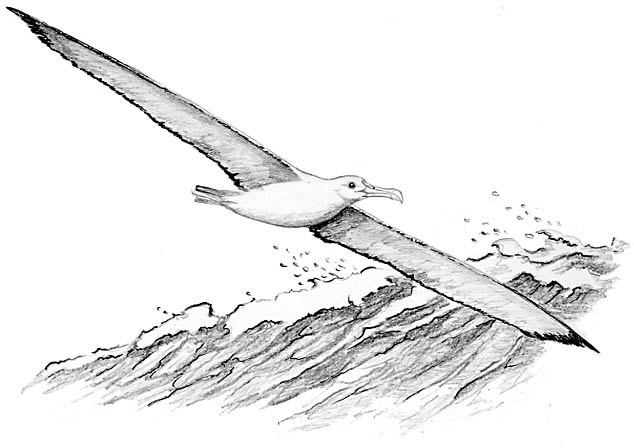
Dear Bird Folks,
I have a question about the bird, the albatross. A friend told me that it can never land on water because if it does land it won’t be able to take off again. Is that true or did my friend have his facts wrong?
– Peter, Harwich, MA
I’m glad you were clear, Peter,
Some people may have thought you were being redundant when you specified “the bird, the albatross.” I mean, what else would an albatross be if it’s not a bird? Well, there are tons of other things that have borrowed the albatross’s name, including a type of plane, boat, hotel, and software program. There’s even an Albatross Pub, a place I must visit someday, for research purposes only. What’s interesting about naming stuff after the bird, the albatross, is that most people have never seen one. Albatrosses are diehard seabirds that have little use for land. Thus, there isn’t much chance of any of us ever seeing one, unless you happen to be a sailor, a fisherman, a pirate, or Gilligan.
There are roughly two dozen different species of albatrosses throughout the world. Most of these birds are found in the North Pacific and in some crazy new area called the “Southern Ocean.” Have you ever heard of that? Me neither, but it sounds like it’s someplace in the south. Only a few screwed up albatrosses ever make it to New England, like the one that was found walking through a cow pasture in Cape Neddick, Maine last spring.
The various albatross species come with a whole assortment of names including the Short-tailed, the Sooty, the Grey-headed, and my favorite, the Shy Albatross. How cute is that? The one most of us are familiar with is the Wandering Albatross. The Wandering Albatross is the bird that was featured in The Rime of the Ancient Mariner, an endlessly long poem that I tried to read last night but stopped after it started to give me a headache. The bird is called “wandering” because it spends years crisscrossing thousands of miles of ocean without ever coming to land. This type of oceanographic wandering should not be confused with the kind of wandering I sometimes experience when I can’t find my car in the mall parking lot. That’s something different.
If you are ever lucky enough to see a Wandering Albatross, you would not be likely to soon forget it. The Wandering Albatross has the largest wingspan of any bird in the world. One particular bird’s wingspan was close to twelve feet long. To give you an idea how huge that is, stick both of your arms straight out, like you did when you were a kid pretending to be an airplane. Now, invite someone else to do the same thing and stand side-by-side, touching fingertips. The distance from the tip of your outside finger to the tip of your partner’s outside finger is about how long a Wandering Albatross’s wings are. Doing this will not only give you a good idea how long this bird’s wingspan is, but it is also a great pick up move. (You may want to write that down, Peter.)
The well-adapted Wandering Albatross has a special tendon that locks its super-long wings into place, allowing it to soar, glider-like, for hours on end with little effort. The bird’s habit of following oceangoing ships made it a favorite bird of sailors who had grown bored with the vast empty ocean, and each other. The bird appears to follow the ships both day and night giving rise to the notion that albatrosses are able to sleep on the wing. However, that notion is widely considered to be false. Instead, when the bird needs to rest, it simply lands on the water’s surface, curls up and goes to sleep. Yes, Peter, the albatross lands on the water, on purpose. After it has a bit of a snooze, the bird wakes up and is airborne in no time.
An albatross can take off from either land or water, but it is far more comfortable in the air. Its landings and takeoffs are sometimes an adventure. If there is no wind the bird must run and flap for quite a while in order to become airborne. And their terrestrial landings are more like crash landings, often involving a somersault or two and looking like the winning entry in America’s Funniest Home Videos.
The Wandering Albatross is a true seabird. The young birds may remain at sea for seven or eight years before they return to land for the first time to breed. The adult female albatross only lays a single egg and she only nests once every two years. Since she is a large bird her egg is also large, about the size of a Coke can, which may explain why she only does it once every two years.
The albatross can definitely take off from the water, Peter. When you tell your friend that he was wrong, do it gently. Better yet, take him to the Albatross Pub. After a while he won’t care what you tell him.